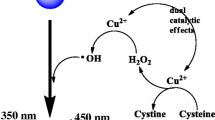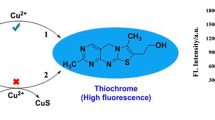Abstract
The authors report that sulfide ions are capable of inhibiting the peroxidase-like activity of copper nanoclusters (CuNCs). The catalytic activity of CuNCs toward the oxidation of the chromogenic substrate 3,3′,5,5′-tetramethylbenzidine by H2O2 is remarkably decreased in the presence of sulfide. Based on this finding, a colorimetric assay was developed for the rapid determination of sulfide. Best operated at a wavelength of 652 nm, it has a 0.5 μM detection limit. The method is highly selective and has been successfully applied to the quantification of sulfide in environmental water samples.

The catalytic activity of CuNCs toward the oxidation of 3,3′,5,5′-tetramethylbenzidine by H2O2 is remarkably decreased in the presence of sulfide ions. This finding has been applied to design a method for colorimetric quantification of sulfide ions in environmental samples.





Similar content being viewed by others
References
Gale P, Caltagirone C (2015) Anion sensing by small molecules and molecular ensembles. Chem Soc Rev 44:4212–4227
Bagarinao T (1992) Sulfide as an environmental factor and toxicant: tolerance and adaptations in aquatic organisms. Aquat Toxicol 24:21–62
Vismann B (1996) Sulfide species and total sulfide toxicity in the shrimp Crangon crangon. J Exp Mar Biol Ecol 204:141–154
Xiong B, Peng L, Cao X, He Y, Yeung E (2015) Optical analysis of biological hydrogen sulphide: an overview of recent advancements. Analyst 140:1763–1771
Xuan W, Sheng C, Cao Y, He W, Wang W (2012) Fluorescent probes for the detection of hydrogen sulfide in biological systems. Angew Chem Int Ed 51:2282–2284
Pawlak Z, Pawlak A (1999) Modification of iodometric determination of total and reactive sulfide in environmental samples. Talanta 48:347–353
Su Y, Yang S, Liu W, Qiao L, Yan J, Liu Y, Zhang S, Fang Y (2017) Visible light photoelectrochemical sulfide sensor based the use of TiO2 nanotube arrays loaded with Cu2O. Microchim Acta 184:4065–4072
Kristiana I, Heitz A, Joll C, Sathasivan A (2010) Analysis of polysulfides in drinking water distribution systems using headspace solid-phase microextraction and gas chromatography-mass spectrometry. J Chromatogr A 1217:5995–6001
Wang C, Sun J, Mei H, Gao F (2017) Organic semiconductor polymer nanodots as a new kind of off-on fluorescent probe for sulfide. Microchim Acta 184:445–451
Yu N, Peng H, Xiong H, Wu X, Wang X, Li Y, Chen L (2015) Graphene quantum dots combined with copper(II) ions as a fluorescent probe for turn-on detection of sulfide ions. Microchim Acta 182:2139–2146
Turan I, Sozmen F (2014) A chromogenic dioxetane chemosensor for hydrogen sulfide and pH dependent off-on chemiluminescence property. Sensors Actuators B Chem 201:13–18
Wang X, Hu Y, Wei H (2016) Nanozymes in bionanotechnology: from sensing to therapeutics and beyond. Inorg Chem Front 3:41–60
Nasir M, Nawaz M, Latif U, Yaqub M, Hayat A, Rahim A (2017) An overview on enzyme-mimicking nanomaterials for use in electrochemical and optical assays. Microchim Acta 184:323–342
Wei H, Wang E (2013) Nanomaterials with enzyme-like characteristics (nanozymes): next-generation artificial enzymes. Chem Soc Rev 42:6060–6093
Lin T, Zhong L, Chen H, Li Z, Song Z, Guo L, Fu F (2017) A sensitive colorimetric assay for cholesterol based on the peroxidase-like activity of MoS2 nanosheets. Microchim Acta 184:1233–1237
Cui W, Wang Y, Yang D, Du J (2017) Fluorometric determination of ascorbic acid by exploiting its deactivating effect on the oxidase–mimetic properties of cobalt oxyhydroxide nanosheets. Microchim Acta 184:4749–4755
Yang H, Yang R, Zhang P, Qin Y, Chen T, Ye F (2017) A bimetallic (Co/2Fe) metal-organic framework with oxidase and peroxidase mimicking activity for colorimetric detection of hydrogen peroxide. Microchim Acta 184:4629–4635
Shang L, Dong S, Nienhaus G (2011) Ultra-small fluorescent metal nanoclusters: synthesis and biological applications. Nano Today 6:401–418
Chen M, Li W, Xiong H, Wen W, Zhang X, Wang S (2017) Discrimination and ultrasensitive detection of β2-agonists using copper nanoclusters as a fluorescent probe. Microchim Acta 184:3317–3324
Tang T, Ouyang J, Hu L, Guo L, Yang M, Chen X (2016) Synthesis of peptide templated copper nanoclusters for fluorometric determination of Fe(III) in human serum. Microchim Acta 183:2831–2836
Hu L, Yuan Y, Zhang L, Zhao J, Majeed S, Xu G (2013) Copper nanoclusters as peroxidase mimetics and their applications to H2O2 and glucose detection. Anal Chim Acta 762:83–86
Yan Z, Niu Q, Mou M, Wu Y, Liu X, Liao S (2017) A novel colorimetric method based on copper nanoclusters with intrinsic peroxidase-like for detecting xanthine in serum samples. J Nanopart Res 19:235
Xu S, Wang Y, Zhou D, Kuang M, Fang D, Yang W, Wei S, Ma L (2016) A novel chemiluminescence sensor for sensitive detection of cholesterol based on the peroxidase-like activity of copper nanoclusters. Sci Rep 6:39157
Zhong Y, Deng C, He Y, Ge Y, Song G (2016) Exploring a monothiolated β-cyclodextrin as the template to synthesize copper nanoclusters with exceptionally increased peroxidase-like activity. Microchim Acta 183:2823–2830
Wang C, Ling L, Yao Y, Song Q (2015) One-step synthesis of fluorescent smart thermo-responsive copper clusters: a potential nanothermometer in living cells. Nano Res 8:1975–1986
Wei W, Lu Y, Chen W, Chen S (2011) One-pot synthesis, photoluminescence, and electrocatalytic properties of subnanometer-sized copper clusters. J Am Chem Soc 133:2060–2063
Koski K, Cha J, Reed B, Wessells C, Kong D, Cui Y (2012) High-density chemical intercalation of zero-valent copper into Bi2Se3 nanoribbons. J Am Chem Soc 134:7584–7587
Jia X, Li J, Wang E (2013) Cu nanoclusters with aggregation induced emission enhancement. Small 9:3873–3879
Hatamie A, Zargar B, Jalali A (2014) Copper nanoparticles: a new colorimetric probe for quick, naked-eye detection of sulfide ions in water samples. Talanta 121:234–238
Deng H, Wu G, Lin X, Xu X, Liu A, Xia X, Chen W (2015) A colorimetric Boolean INHIBIT logic gate for the determination of sulfide based on citrate-capped gold nanoparticles. RSC Adv 5:58574–58579
Chen C, Zhao D, Lu L, Yang F, Yang X (2015) A simple and rapid colorimetric sensor for sulfide anion detection based on redox reaction of ABTS with au (III). Sensors Actuators B Chem 220:1247–1253
Liu L, Wang Y, Fu W (2017) Highly selective detection of sulfide through poisoning silver nanoparticle catalysts. Sensors Actuators B Chem 247:414–420
Zhang J, Xu X, Yang X (2012) Highly specific colorimetric recognition and sensing of sulfide with glutathione-modified gold nanoparticle probe based on an anion-for-molecule ligand exchange reaction. Analyst 137:1556–1558
Shanmugaraj K, Ilanchelian M (2016) Colorimetric determination of sulfide using chitosan-capped silver nanoparticles. Microchim Acta 183:1721–1728
Acknowledgements
This work was supported by the National Natural Science Foundation of China (NSFC, 21605012), Scientific and Technological Research Program of Chongqing Municipal Education Commission (No. KJ1600301), and the Program for Top-Notch Young Innovative Talents of Chongqing Normal University (No. 02030307-00043).
Author information
Authors and Affiliations
Corresponding author
Ethics declarations
The authors declare that they have no competing interests.
Electronic supplementary material
ESM 1
(DOCX 7433 kb)
Rights and permissions
About this article
Cite this article
Liao, H., Hu, L., Zhang, Y. et al. A highly selective colorimetric sulfide assay based on the inhibition of the peroxidase-like activity of copper nanoclusters. Microchim Acta 185, 143 (2018). https://doi.org/10.1007/s00604-018-2701-1
Received:
Accepted:
Published:
DOI: https://doi.org/10.1007/s00604-018-2701-1




